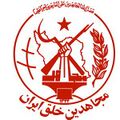People's Mojahedin Organization of Iran
This article may require copy editing for grammar, style, cohesion, tone, or spelling. |
People's Mojahedin Organization سازمان مجاهدين خلق | |
|---|---|
 | |
| Abbreviation | PMOI, MEK, MKO |
| Leader |
Maryam Rajavi Massoud Rajavi |
| Secretary-General | Zahra Merrikhi |
| Founders |
Mohammad Hanifnejad Saeid Mohsen Ali-Asghar Badi'zadegan Ahmad Rezaei |
| Founded | 5 September 1965 |
| Banned | 1981 (in Iran) |
| Split from | Freedom Movement of Iran |
| Headquarters | |
| Newspaper | Mojahed |
| Political wing |
National Council of Resistance of Iran (1981–present) |
| Military wing | National Liberation Army (1987–2003) |
| Membership | 5,000 to 10,000 (DoD 2011 est.) |
| Religion | Shia Islam |
| Website | |
| www.mojahedin.org | |
Mojahedin-e-Khalq (MEK) (lit. "People's Mujahideen"), known in English as the People's Mojahedin Organization of Iran (PMOI) or Mojahedin-e-Khalq Organization (MKO), is a formerly communist political group which supports regime change in the Islamic Republic of Iran. The MEK has been described as a "cult" which has degenerated from its leftist political advocacy in the 1980s into reportedly torturing and sterilizing its own members.[1][2] However, it was removed from the United States list of terrorist groups in 2012 and continues to enjoy support from influential US politicians. The US government has cited the group as a potential replacement for the current government in the event of an overthrow, despite its wide unpopularity[3][4][5] and alienation from the Iranian masses.
The MEK was founded in the 1960s in opposition to the Shah. After the 1979 seizure of power by Islamists in the Islamic Revolution, the organization was heavily repressed by the Iranian government along with other leftist elements in the country. In 1986, the MEK joined the Iran-Iraq War on the side of the Iraqi government and was involved in a number of key military operations. When the war ended in 1988, the Iranian government viciously persecuted the group and killed thousands or tens of thousands of its members.
After the United States overthrew Saddam Hussein in its 2003 invasion, the US initially fought the Iraq-based MEK but, in 2004, abruptly reversed its position. Bush administration officials Dick Cheney and Donald Rumsfeld reportedly viewed the organization as useful in countering Iran and designated the group as "protected persons" under the Geneva Convention,[citation needed] allowing for its safe passage during the brutal war. The group disarmed and became primarily an advocacy group.[2] In 2016, the United States brokered a deal to relocate 3,000 members of the MEK to Albania and donated $20 million to the UN refugee agency to help them resettle.[citation needed]
The Iran Policy Committee, an MEK advocacy group supported by "former officials from the White House, State Department, Pentagon, intelligence agencies, Congress, and experts from think tanks and universities",[6] began advocating for the group's de-listing as a terrorist organization since at least 2005[6][7] which Secretary of State Hillary Clinton eventually did in 2012. Since the de-listing, the MEK and its front groups have advocated to present the group as a viable alternative to the current government of the Islamic Republic. Supporters of the MEK have received copious amounts of lobbying money, and the organization has been considered a source of corruption in the US government.[1] As of 2023, the group is supported by dozens of prominent political figures, such as former NYC mayor Rudy Giuliani, notorious anti-Iran hawks John Bolton, Mike Pompeo, and Michèle Flournoy, and sitting Congress members such as Kevin McCarthy, Hakeem Jeffries, Joe Lieberman, Ted Cruz, Bob Menendez, and Cory Booker.[1][2] In 2022, the Iranian government sanctioned[clarification needed] 61 current and former US officials for their connection to the group.[8]
According to The Intercept, the organization's sources of its ample funding "remain unclear", with possible benefactors including Gulf Arab states such as Saudi Arabia. The group also has clear ties to Israel and Israeli intelligence: in 2002, the MEK was the first to report that Iran was pursuing enriched uranium, information which was likely obtained from the Mossad.[7] In addition, MEK is confirmed to have participated in Israel's assassinations of Iranian nuclear scientists which started in 2007.[2][7] The MEK has been called an "information launderer"[citation needed] and "deniable asset"[2] of the Mossad.
See also
- Falun Gong, a similar organization which advocates for regime change in the PRC
Notes
References
- ↑ 1.0 1.1 1.2 Rubin, Michael (15 Jul 2021). "The Mujahedin-e-Khalq has become a barometer of Washington corruption". Washington Examiner. Retrieved 9 Oct 2023.
- ↑ 2.0 2.1 2.2 2.3 2.4 Hussain, Murtaza; Cole, Matthew (22 Mar 2020). "Defectors Tell of Torture and Forced Sterilization in Militant Iranian Cult". The Intercept. Archived from the original on 1 Oct 2023. Retrieved 9 Oct 2023.
- ↑ Dehghan, Saeed Kamali (22 Apr 2014). "Iranian prisoners allegedly forced to run gauntlet of armed guards". the Guardian. Retrieved 9 Oct 2023.
- ↑ Torbati, Yeganeh (16 Jan 2017). "Former U.S. officials urge Trump to talk with Iranian MEK group". U.S. Retrieved 9 Oct 2023.
- ↑ Gharib, Ali; Clifton, Eli (26 Feb 2015). "How a One-Time Terrorist Group Prevailed on Capitol Hill". The Intercept. Archived from the original on 10 May 2018. Retrieved 9 Oct 2023.
- ↑ 6.0 6.1 "Iran policy group outlines new approach in dealing with Tehran". Iran Focus. 14 Feb 2005. Retrieved 9 Oct 2023.
- ↑ 7.0 7.1 7.2 Hersh, Seymour (5 Apr 2012). "Our Men in Iran?". The New Yorker. Archived from the original on 4 Oct 2023. Retrieved 9 Oct 2023.
- ↑ Motamedi, Maziar (16 Jul 2022). "Iran blacklists US officials for supporting 'terrorist' group MEK — Armed Groups News". Al Jazeera. Retrieved 9 Oct 2023.